Societas Heraldica Slovenica
November 2005
Cathedral of St. Nicholas, Ljubljana
Although heraldry is not one of the strong points of the Cathedral of St. Nicholas, Ljubljana, heraldry does indeed exist in the cathedral, and are particularly well rendered and detailed. Before examining a few of the arms captured on camera, a brief on the history of the cathedral is in order. All photographs in this article courtesy by the author.
History of the Cathedral
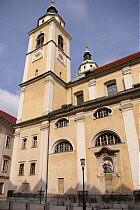 | south facade, west end
adjacent Ciril-Metodov trg |
St. Nicholas' Cathedral is situated between the Ciril Metodov trg and the Ljubljanica river in central Ljubljana in what is known as the "old town" area. Earliest records indicated that a church structure has been standing at this location ever since the late 13th century (approximately 1262). The church is dedicated to the patron St. Nicholas, the guardian of fishermen and boatmen. The original church was constructed in the style of Romanesque architecture [ 1 ] sometime between the 11th and 12th centuries.
After a fire in 1361 which destroyed the church, it was later rebuilt, architected in the Gothic style [ 2 ]. During the 15th century this church went through several alterations and renovations. When Ljubljana was established as the center of episcopal in 1461, the church was granted 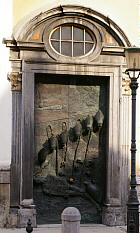 | south facade bronze door, one
of two showing reliefs of
the Bishops of Ljubljana |
cathedral status in 1469, it was destroyed once again by the Turks. The ruins of the second church having only a single bell tower was pulled down around 1700, and a third reconstruction of the structure occurred resulting in the present day, St. Nicholas Cathedral using a more conventional architectural style consistent with the style found in Ljubljana and surrounding areas.
The design of the cathedral included two towers which was the traditional design of construction of churches in Ljubljana and the surrounding region since the beginning of the 17th century. Following this tradition, the Jesuit Andrea Pozzo [ 3 ], an architect and designer from Rome, designed the church as it stands today. The design was inspired by the Jesuit churches Il Gesu and S. Ignazio in Rome. Giulio Quaglio [ 4 ], an already famous painter from Italy decorated the interior of the church with frescoes between 1703 to 1706 and 1721 to 1723. Giulio 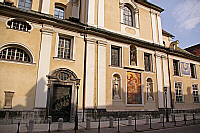 | south facade depicting the bishops of
Ljubljana bronze door installed in 1996 |
Quaglio also designed a simulated cupola in wood. The present-day cupola was erected in 1844 and decorated by Matevž Langus [ 5 ].
In 1996, two enhancements were installed on the cathedral in the form of two large bronze doors, one on the west facade and the second on the south facade adjacent to Ciril-Metodov trg. These were added to commemorate the visit of Pope John Paul II. The stunning west door is decorated with a raised relief scenes depicting 1,200 years of Christianity in Slovenia including scenes of the Crusades through to the independence of Slovenia, while the south door is decorated with the raised relief of the bishops of Ljubljana.
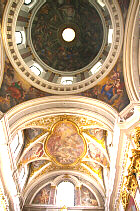 | 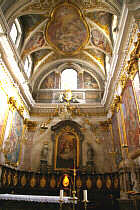 | the ceiling with a partial view
of the interior of the dome | view of the high alter |
The historical overview of the Cathedral is not complete without some details regarding the interior of the structure. The obvious focal point of such a cathedral is the high alter and the fantastically painted frescoes on the vaulted ceilings, in particular, the interior of the dome painted by Matevž Langus (a later structure added to the cathedral in 1844). As one walks through the cathedral, with head bent upwards, one can only appreciate the significance and detail of the beautiful paintings by visiting the cathedral in person, as photographs do little justice to the majesty of the artwork. One is compelled to visually glide over the paintings numerous times as more detail become apparent with each visual passage. The vaulted ceilings gives the impression of a living organizm that instills a sense of timeliness, which appears to have survived the ravages of time and human action over the centuries. For individuals atuned to heraldry, will observe the heraldic coats of arms painted at the tops of the four columns which support the dome. At the time of this writing, there is little information as to the reasoning to include these arms in the decor, but one can surmise that the individuals may have contributed some significant donation, probably with respect to the construction of the dome and thereby, having their arms included in the architecture in recognition of their contribution. It was evident that there were no other instances of heraldic arms in the cathedral, however, it is possible that the author may have missed other heraldic arms that may have been present in the cathedral. With the incredible detail of the paintings in the cathedral, the structure deserves another visit to more fully examine the interior. Details on the arms photographed follow in the next paragraph.
Coats of Arms at Cathedral St. Nicholas...
The images below depict the four coats of arms visible at St. Nicholas Cathedral. The arms can be seen on seen at the tops of the four pillars which support the dome. It can be surmised that the personal arms are those noble families or individuals who have contributed in some significant way to the church during the time of the construction of the dome in the mid-19th century. The arms were created in a shape in what is known in heraldry as a "lozenge" shape.
Cross-referencing the images of the arms with Valvasor's Opus Insignium Armorumque, we discover that the first coat of arms (below, first on the left) are those belonging to von Khienburg found on pp. 53, 190, 242 in the armory. The first rendering of v. Khienburg can be found on plate 53, which is the section of the armory presenting the coats of arms of Carniolan provincial officers. A second rendering of the same arms is found on plate 190, which is in the Styrian coats of arms section of the armory. This section contains arms of families from the then Styrian (Štajersko) region, many of whom owned land in Carniola, and of Carniolan families who had estates in the Štajersko region. The arms appear once again on plate 242, the section also covering Styrian coats of arms, but in this particular section, the arms are not presented in any alphabetic order, and to add, the arms of von Khienburg on plage 242 are not rendered identically as they are in the earlier sections of the armory.
 |
 |
 |
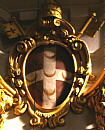 |
| von Khienburg |
von Heberstein |
un-identified arms |
un-identified arms |
Further analysis of the arms at the Cathedral, using Valvasor's Opus Insignium Armorumque, we discover that the second arms from the left (above) are those belonging to von Heberstein found on pp. 14, 38, 66, 102, 256, 276 in the armory. The first rending of von Heberstein arms can be found on plate 14, which is the section of the armory presenting the coats of arms of Ljubljana bishops, according to their period in office. Žiga Herberstein held office between the years 1683 - 1701. [ 6 ] His arms are rendered on plate 38, indicating that the von Heberstein family 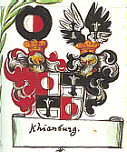 | 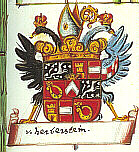 | von Khienburg arms from
Valvasor's armory | von Heberstein arms from
Valvasor's armory |
had family members who were generals in the Karlovac [ 7 ], and who also may have been representatives of Carniolan and Styrian nobility. Having his arms included on plate 66 indicates that he was a member of a provincial committee in Carniola. The appearance of his arms on plate 102 indicates that he was a lower-ranking baron who used to own lands in Carniola. In this section of the armory, extinct families are identified with a cross in the armorial achievement and von Heberstein's arms are not marked in such a manner. The next plate that has his arms is plate 256, which is in the section of the armory depicting Carinthian coats of arms of noble families. Whether this indicates that von Heberstein was both of noble Carinthian birth and a lower baron in Carniola requires further analysis. The last plate, 276, is in the section of Valvasor's armory depicting German coats of arms. The arms presented in this section of Valvasor's armory were sourced from J.Siebmacher's armorial, first published in 1596.
It is clear that heraldry played an important role in Slovenian history by virtue of numerous instances of the representation of individuals or families through the creation of a facsimile of coats of arms in architecture, including St. Nicholas Cathedral in Ljubljana. It is also important to note that further heraldic research is necessary to identify the many other coats of arms found throughout Slovenia in other architectural monuments in order to more fully appreciate their heraldic history and the contributions made by the families, noble or otherwise to the evolution of Slovenia. If in the future, the other unidentified arms depicted above become known, those updates will be reflected in this article.
Footnotes
- Romanesque Architecture is a term to describe a style of architecture in the style of Rome appearing in Europe sometime during the late 10th century through to the late 12th century. This form of architecture was characterized by the use of rounded or slightly pointed arches and vaulted ceilings. A classic example of this style of architecture still standing can be found at Duomo Pisa, Italy.
- Gothic Architecture is a prejorative term used since the early 16th century originally describing a culture that was rude and barbaric which inferred the Germanic culture and later applied to the architectural styles found in northern Europe. The Gothic architecture is characterized by the almost skeletal stone structures with expanses of stained glass, emphasizing verticality in the form of sharply pointed spires, cluster columns and pointed arches, all giving the appearance of reaching for the heavens and therefore, closer to God. There are many examples of Gothic architecture still standing today, such as Duomo, Milano, Italy and Cathedral Notre-Dame of Reims in France.
- Andrea Pozzo (1642 - 1709), was an extraordinarily versatile artist, an architect, decorator, painter, art theoretician, one of the most significant figures of Baroque Gesamtkunst. He entered the Jesuit order at an early age, and his artistic activity is also related to the order's enormous artistic enterprises. His masterpiece, the decoration of Rome's Jesuit churches Il Gesu and San Ignazio, determined for several generations the style of internal decoration of Late Baroque churches in almost all Europe.
- Giulio Quaglio (1668-1751) was a notable Baroque painter, who was also responsible for the frescoes in the Cathedral of St. Nicholas, Ljubljana.
- Matevž Langus (1792 - 1855) was one of the most prolific Slovenian painters during the 19th century, with a focus on religious and frescoes artwork.
- Cerkev na Slovenskem (Churches in Slovenia). Ljubljana, 1971. p.50.
- Karlovac is located approximately 30 km south of Metlika, Slovenia was the principal fortress for the defence of Carniola and Croatia, the site chosen by the Archduke of' Styria, Commander in Chief of the Military Frontier, Charles (Karlo) of Habsburg, built in 1579.
Bibliography
by David M. Cvet
Societas Heraldica Slovenica
November 2005
About the author: , born in Canada, son of Slovenian parents, is director of the Royal Heraldry Society of Canada (RHSC), president of the Toronto Branch of the RHSC, president and founder of the Academy of European Medieval Martial Arts in Toronto, and is also the founder of the Societas Heraldica Slovenica. During his study, research and reconstruction of medieval martial arts, he discovered heraldry had played a significant part in medieval history, and has expanded his research and study to include heraldry of Slovenia.
SHS Copyright © 2005 All Rights Reserved
Updated: November 1, 2005
|










